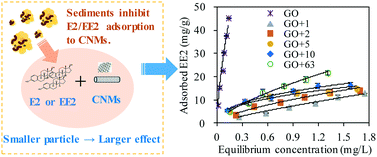当前位置:
X-MOL 学术
›
Environ. Sci.: Nano
›
论文详情
Our official English website, www.x-mol.net, welcomes your feedback! (Note: you will need to create a separate account there.)
Sediments inhibit adsorption of 17β-estradiol and 17α-ethinylestradiol to carbon nanotubes and graphene oxide
Environmental Science: Nano ( IF 7.3 ) Pub Date : 2017-08-02 00:00:00 , DOI: 10.1039/c7en00416h Weiling Sun 1, 2, 3, 4, 5 , Menglin Li 6, 7, 8, 9, 10 , Wei Zhang 11, 12, 13, 14, 15 , Jingmiao Wei 1, 2, 3, 4, 5 , Ben Chen 10, 16, 17, 18 , Conghe Wang 1, 2, 3, 4, 5
Environmental Science: Nano ( IF 7.3 ) Pub Date : 2017-08-02 00:00:00 , DOI: 10.1039/c7en00416h Weiling Sun 1, 2, 3, 4, 5 , Menglin Li 6, 7, 8, 9, 10 , Wei Zhang 11, 12, 13, 14, 15 , Jingmiao Wei 1, 2, 3, 4, 5 , Ben Chen 10, 16, 17, 18 , Conghe Wang 1, 2, 3, 4, 5
Affiliation

|
Increasing use of carbonaceous nanomaterials (CNMs) in many industrial and commercial applications has raised concern over their potential environmental impacts. However, little is known about how the released CNMs could interact with other contaminants in aquatic environments. In this study, the effects of sediment particle size (<1 μm, 1–2 μm, 2–5 μm, 5–10 μm, and 10–63 μm) and organic matter (OM) on adsorption of 17β-estradiol (E2) and 17α-ethinylestradiol (EE2) to carboxylated multi-walled carbon nanotubes (CNTs) and graphene oxide (GO) were investigated using batch adsorption experiments in combination with microscopic, spectroscopic, and computational techniques. The adsorption of E2 and EE2 to CNMs was much stronger than that to the sediments, resulting from π–π interactions and hydrogen bonding, as confirmed with density functional theory calculations. Nonetheless, the presence of sediments inhibited E2/EE2 adsorption to CNTs or GO, and the inhibition effect increased with decreasing sediment particle size. This inhibition effect resulted from the attachment of CNMs to the sediment surface and subsequent blockage of the adsorption sites on CNMs. The removal of OM in the sediments enhanced the inhibition effect, likely due to stronger attachment of CNMs on OM-free sediments. These observations were corroborated by microscopic visualization and DLVO calculations. Our results provided new insights into the effect of sediments on contaminant adsorption by CNMs, as modulated by sediment particle size and OM.
中文翻译:

沉积物抑制17β-雌二醇和17α-炔雌醇吸附到碳纳米管和氧化石墨烯上
碳纳米材料(CNM)在许多工业和商业应用中的使用越来越多,引起了人们对其潜在环境影响的关注。但是,人们对释放的CNM如何与水生环境中的其他污染物相互作用知之甚少。在这项研究中,沉积物粒径(<1μm,1-2μm,2-5μm,5-10μm和10-63μm)和有机物(OM)对17β-雌二醇(E2 )和17α-炔雌醇(EE2)对羧化多壁碳纳米管(CNTs)和氧化石墨烯(GO)进行了研究,采用批吸附实验结合微观,光谱和计算技术进行了研究。由于π-π相互作用和氢键作用,E2和EE2对CNM的吸附要强于对沉积物的吸附。正如密度泛函理论计算所证实的那样。尽管如此,沉积物的存在抑制了E2 / EE2对CNTs或GO的吸附,并且抑制作用随沉积物粒径的减小而增加。这种抑制作用是由于CNMs附着在沉积物表面上,以及随后堵塞了CNMs上的吸附位。去除沉积物中的OM会增强抑制效果,这可能是由于CNM在无OM的沉积物中更牢固地附着所致。这些观察结果通过显微镜可视化和DLVO计算得到了证实。我们的结果为沉积物对CNM吸附污染物的影响提供了新的见解,并受沉积物粒径和OM的调节。随着沉积物粒径的减小其抑制作用增强。这种抑制作用是由于CNMs附着在沉积物表面上,以及随后堵塞了CNMs上的吸附位。去除沉积物中的OM会增强抑制效果,这可能是由于CNM在无OM的沉积物中更牢固地附着所致。这些观察结果通过显微镜可视化和DLVO计算得到了证实。我们的结果为沉积物对CNM吸附污染物的影响提供了新的见解,并受沉积物粒径和OM的调节。随着沉积物粒径的减小其抑制作用增强。这种抑制作用是由于CNMs附着在沉积物表面上,以及随后堵塞了CNMs上的吸附位。去除沉积物中的OM会增强抑制效果,这可能是由于CNM在无OM的沉积物中更牢固地附着所致。这些观察结果通过显微镜可视化和DLVO计算得到了证实。我们的结果为沉积物对CNM吸附污染物的影响提供了新的见解,其受沉积物粒径和OM的调节。可能是由于CNM更牢固地附着在不含OM的沉积物上。这些观察结果通过显微镜可视化和DLVO计算得到了证实。我们的结果为沉积物对CNM吸附污染物的影响提供了新的见解,其受沉积物粒径和OM的调节。可能是由于CNM更牢固地附着在不含OM的沉积物上。微观可视化和DLVO计算证实了这些观察结果。我们的结果为沉积物对CNM吸附污染物的影响提供了新的见解,并受沉积物粒径和OM的调节。
更新日期:2017-09-14
中文翻译:

沉积物抑制17β-雌二醇和17α-炔雌醇吸附到碳纳米管和氧化石墨烯上
碳纳米材料(CNM)在许多工业和商业应用中的使用越来越多,引起了人们对其潜在环境影响的关注。但是,人们对释放的CNM如何与水生环境中的其他污染物相互作用知之甚少。在这项研究中,沉积物粒径(<1μm,1-2μm,2-5μm,5-10μm和10-63μm)和有机物(OM)对17β-雌二醇(E2 )和17α-炔雌醇(EE2)对羧化多壁碳纳米管(CNTs)和氧化石墨烯(GO)进行了研究,采用批吸附实验结合微观,光谱和计算技术进行了研究。由于π-π相互作用和氢键作用,E2和EE2对CNM的吸附要强于对沉积物的吸附。正如密度泛函理论计算所证实的那样。尽管如此,沉积物的存在抑制了E2 / EE2对CNTs或GO的吸附,并且抑制作用随沉积物粒径的减小而增加。这种抑制作用是由于CNMs附着在沉积物表面上,以及随后堵塞了CNMs上的吸附位。去除沉积物中的OM会增强抑制效果,这可能是由于CNM在无OM的沉积物中更牢固地附着所致。这些观察结果通过显微镜可视化和DLVO计算得到了证实。我们的结果为沉积物对CNM吸附污染物的影响提供了新的见解,并受沉积物粒径和OM的调节。随着沉积物粒径的减小其抑制作用增强。这种抑制作用是由于CNMs附着在沉积物表面上,以及随后堵塞了CNMs上的吸附位。去除沉积物中的OM会增强抑制效果,这可能是由于CNM在无OM的沉积物中更牢固地附着所致。这些观察结果通过显微镜可视化和DLVO计算得到了证实。我们的结果为沉积物对CNM吸附污染物的影响提供了新的见解,并受沉积物粒径和OM的调节。随着沉积物粒径的减小其抑制作用增强。这种抑制作用是由于CNMs附着在沉积物表面上,以及随后堵塞了CNMs上的吸附位。去除沉积物中的OM会增强抑制效果,这可能是由于CNM在无OM的沉积物中更牢固地附着所致。这些观察结果通过显微镜可视化和DLVO计算得到了证实。我们的结果为沉积物对CNM吸附污染物的影响提供了新的见解,其受沉积物粒径和OM的调节。可能是由于CNM更牢固地附着在不含OM的沉积物上。这些观察结果通过显微镜可视化和DLVO计算得到了证实。我们的结果为沉积物对CNM吸附污染物的影响提供了新的见解,其受沉积物粒径和OM的调节。可能是由于CNM更牢固地附着在不含OM的沉积物上。微观可视化和DLVO计算证实了这些观察结果。我们的结果为沉积物对CNM吸附污染物的影响提供了新的见解,并受沉积物粒径和OM的调节。



























 京公网安备 11010802027423号
京公网安备 11010802027423号